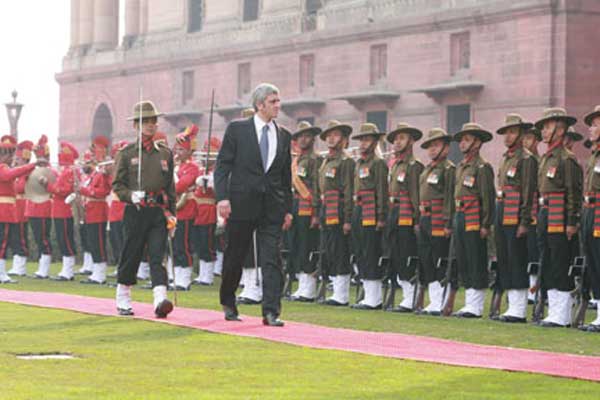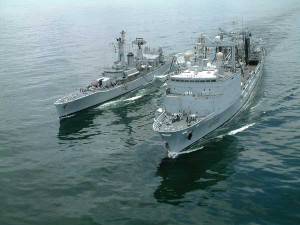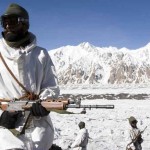Historical Background: To grasp the intricacies of Indo-French relations in the field of defence and security, it is necessary to first have a look at some issues which may seem unrelated, but which will help us to understand the historical background and get clearer perspectives on the future.
The Partition: Let us go back for a moment to 1946-47, when the British decided to leave the Jewel in their Crown. They were ready to depart from the subcontinent, but not to lose their influence in Asia. During the previous two centuries, the defence of their empire had been centered on the Indian subcontinent and the Indian Ocean was known as the ‘British lake’.
According to many, the Pakistani invasion of Kashmir opened Nehrus eyes; India had to defend itself. Nonetheless, India was still not ready when the Chinese descended the slopes of Thagla ridge on October 20, 1962.
The British Empire, born from a trading company, was basically a sea-empire. This has been demonstrated by the historian K.M. Panikkar, in his book, Asia and the Western Dominance. At the beginning of the 20th century however, two new factors appeared on the strategic scene: one was aviation (as masterfully demonstrated by the Japanese at Pearl Harbour in 1941); the second, petrol and the resulting importance given to the Middle East.
In 1946, when the British Chiefs of Staff were ordered to submit a report on the strategic consequences of Britain’s departure from the subcontinent,1 the generals agreed that Pakistan was the more important of the two future dominions; first because of the possibility of installing air bases in the north of the country (to control Soviet advances) and second, naval bases could be opened on the Arabian Sea in the South. As an added bonus, a strong support to Pakistan could have a positive influence on the Muslim states in the Middle East.
On August 15, 1947, the subcontinent was partitioned. The con-sequences are still today looming over the region. One of the results of the British assessment was that during the first decades after independence, the West most often took Pakistan’s side over India, particularly in the Kashmir imbroglio. This aggravated the tensions and resulted in Delhi seeing Pakistan as the major (and often only) threat to its security and thus choosing to lean towards the Soviets.
Though the French foreign policy did not tilt so blatantly towards Karachi, Paris remained an ally of the Western nations during the Cold War. French interests were in keeping a more balanced approach between the two former dominions. 2
Non-Violence: The Ideological Factor
Another aspect to take into consideration is the ideological slant of some of the first leaders of Independent India.
The new Indian government, which had championed the principle of non-violence against the British, was keen to show the world that conflicts could be solved without recourse to force. According to many, the Pakistani invasion of Kashmir opened Nehru’s eyes; India had to defend itself. Nonetheless, India was still not ready when the Chinese descended the slopes of Thagla ridge on October 20, 1962.
The Colonial Factor
Another factor which weighed heavily in the Indo-French relations is the hangover of the colonial era. The British left the subcontinent in August 19473, while the French remained present in five tiny establishments.
The total arms sales from France between 1950 and 1962 amounted to $794 million according to the SIPRI database,7 which made it the second most important after UK ($4,612 million) and before USSR ($612 million) and the US ($248 million).
For several reasons,4 Paris could not follow the British example at that time, but over the years it became increasingly difficult to come out of the entrenched positions and to find an honourable exit for France to return to India the suzerainty over the French Establishments in India.
Only the wisdom and the determination of the French Premier Pierre Mendès-France in 1954 saved both nations from a longer and even more unpleasant conflict.5
It is also important to note the parallel between the fate of the French Establishments in India and the situation in other French colonies, particularly in Indochina and North Africa.
The de facto transfer of the French Establishments was linked with the fate of the Geneva Conference on Indochina and the de jure transfer was ratified by the Parliament soon after the Evian Agreement on Algeria. These elements, external to the bilateral relations between India and France played an important historical role.
The Defence Relations First phase: 1947-1962
Historians usually consider the period between 1947 and 1962 as the first phase of the Indo-French relations. Year 1962 was for France the year it constitutionally departed from the subcontinent and for India, it marked the end of the dream of a Hindi-Chini bhai-bhai relationship.
Though the relations were not too cordial between France and India, as early as January 1947, the French Government asked for a ten-year extension of the 1945 agreement permitting military air ferries to fly across India. Nehru, the Interim Prime Minister noted: “Public opinion in India is very much against the use of force by the French Government against the people of Indochina and anything which we do to facilitate the use of this force is bound to be resented and vigorously criticised.” On July 16, 1947 an Agreement on Air Services between India and France was nevertheless signed.
By the end of the year, an interesting development occurred. Nehru was “anxious to help in every way in developing atomic energy in India.” He decided to unofficially send Dr. Homi J. Bhabha to enquire about the possibility of collaboration for the peaceful use atomic energy: “In view of the fact that India possesses very large resources of minerals suitable for the generation of atomic power, India is destined to play an important part in research on atomic energy in co-operation with other countries. We would like to welcome this co-operation, more specially in Great Britain, Canada and France.” Homi Bhabha had extremely cordial contacts with Frédéric Joliot-Curie and Raoul Dautry, the first heads of the French Atomic Energy Commission (CEA), founded by de Gaulle in 1945. At that time, Joliot-Curie was interested by two materials: beryllium and thorium. Nehru, interested in the program ‘Atoms for Peace’, saw the nuclear collaboration as discriminatory. Why should countries with colonial territories use raw material looted from these colonies for their research, he thought.






